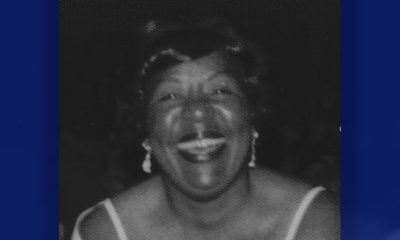Black History
The Black Girl Magic is Real—Taliaferro, Bennett latest Pittsburgh Black women to win elections
NEW PITTSBURGH COURIER — Magic is defined as “the power of apparently influencing the course of events by using mysterious or supernatural forces.” But in Pittsburgh, Devon Taliaferro and Olivia Bennett aren’t “mysterious or supernatural forces.” They are Black women, born and raised in this area, who sought to make change—in Taliaferro’s case, the school system, or in Bennett’s case, the justice system.
By Rob Taylor Jr.
Magic is defined as “the power of apparently influencing the course of events by using mysterious or supernatural forces.”
But in Pittsburgh, Devon Taliaferro and Olivia Bennett aren’t “mysterious or supernatural forces.” They are Black women, born and raised in this area, who sought to make change—in Taliaferro’s case, the school system, or in Bennett’s case, the justice system.
There is a popular hashtag/trending topic circulating across America, labeled #Blackgirlmagic. The concept was formed in 2013 “to celebrate the beauty, power and resilience of Black women.”
You can add Taliaferro and Bennett to Pittsburgh’s growing list of #Blackgirlmagic, after they won their primary election races on May 21.
Taliaferro, 38, dominated the Pittsburgh Public Schools Board District 2 race, besting three other contenders with 34 percent of the total vote. Bennett, 40, surprised many with a victory over challenger Denise Ranalli Russell for Allegheny County Council District 13. Bennett had 58 percent of the vote, Russell tallied 41 percent.
In this heavily Democratic area, both Taliaferro and Bennett won’t have any problems winning the November general election. Thus, you can make their positions on the board and council, respectively, a formality.
“We handle stuff, we make stuff happen,” Bennett told the New Pittsburgh Courier, May 21, about Black women in general. “And I believe that we have the knowledge…we can talk intelligently about policy issues, about things that need to be done. Some of us are coming from a place of poverty, some of us are coming from socio-economic disadvantage, some of us are coming from projects, we have all these different perspectives. It just makes sense that we would be entering public office.”
Added Taliaferro: “Black women are taking over, the Black girl magic is real, and I think it’s important because Black women have so much power and we have a great voice.”
In just the last 18 months, the Pittsburgh area has watched Marita Garrett become Wilkinsburg’s first Black female mayor, Summer Lee become the first Black female state representative in Western Pennsylvania (outside city limits), Nickole Nesby become the first Black female mayor of Duquesne, and Chardae Jones take the throne as mayor of Braddock.
In the May 21 primary election for state Superior Court, Amanda Green-Hawkins garnered the most votes of any candidate—Democrat or Republican—and is in the running to win one of two vacant seats on the court in the November general election.
“I think it’s underrated (the power of Black women),” Taliaferro told the Courier moments after her victory. “We work hard…we deserve to be acknowledged for that hard work. I think it feels good when people can say, ‘I believe in you,’ ‘I think that you can do it,’ and that’s what I’ve experienced.”
Taliaferro grew up in Wilkinsburg, graduated from Wilkinsburg High School in 1999, then attended Indiana University of Pennsylvania and the University of Pittsburgh. The East Allegheny resident currently is a program associate with Big Brothers Big Sisters of Greater Pittsburgh. She runs two mentoring programs—one at Brashear High School, the other at Greenfield Elementary. With her being in the schools, Taliaferro’s decision for running for school board was “solely on the experiences that I’ve had and the conversations that I’ve had with my students. I talk to kids all the time, I hear that they don’t like lunch, I see them get suspended for outrageous reasons. I see the issues and I see the needs that they have and they deserve better,” she said.
Taliaferro has two main priorities as a soon-to-be board member—first, “making sure our kids are staying in the classroom, that we’re really working towards the solutions that need to happen in order for us to eliminate suspensions…and invest more into the restorative justice practices that exist in the district. And second, investing in more PPS-designated “community schools.” Taliaferro wants to increase the resources that students need to be successful in the home and classroom. But what are those resources? Taliaferro said that is best answered by the parents. Thus, he wants to “engage (parents) and meet them where they are,” such as their child’s football game.
As for Bennett, she couldn’t believe what happened to Antwon Rose II. “When we witnessed a young boy getting shot in the back three times, running away from an officer…we can’t blame a young boy,” she told the Courier after her victory. “This officer was out to serve and protect…I don’t think shooting a boy in the back three times is serving or protecting. We have over 100 police departments in Allegheny County. They are not all working on the same standards and protocols. We need to fix that.”
Rose, 17, was shot to death by former East Pittsburgh Police Officer Michael Rosfeld in June 2018, and was found not guilty of criminal homicide by a jury in March.
Bennett’s primary focus as a future member of county council is the implementation of a county-wide citizen police review board. “Just because you cross over into another municipality, which can happen just by crossing the street in some places,” Bennett said that doesn’t mean a police department’s policies should change.
“We need to have a clear definition on how we are policed in our communities and that is what that county citizen police review board (is for),” Bennett said.
Bennett is a 1996 graduate of Oakland Catholic High School, and earned a bachelor’s degree in business from Carlow University. She’s about to attend the University of Pittsburgh’s Graduate School of Public and International Affairs.
Bennett, a Northview Heights resident, celebrated with family, friends and the Taliaferro contingent at Walter’s BBQ Southern Kitchen in Lawrenceville, after learning of the election results.
The mood was festive, as one would expect. The hugs for Bennett and Taliaferro were aplenty, the outpouring of support was abundant.
Absent from the celebration were David Copperfield and David Blaine, two of America’s most famous magicians.
No problem. Taliaferro and Bennett brought their own magic—#Blackgirlmagic.
“We’re tired of people speaking for us that don’t look like us, that don’t live our experiences, but want to continue making policy that is harming us,” Bennett told the Courier. “I think that people around the county are fed up with this, and you see that today.”
Like us at https://www.facebook.com/pages/New-Pittsburgh-Courier/143866755628836?ref=hl
Follow @NewPghCourier on Twitter https://twitter.com/NewPghCourier
This article originally appeared in the New Pittsburgh Courier.
Activism
Oakland Post: Week of November 26 – December 2, 2025
The printed Weekly Edition of the Oakland Post: Week of November 26 – December 2, 2025
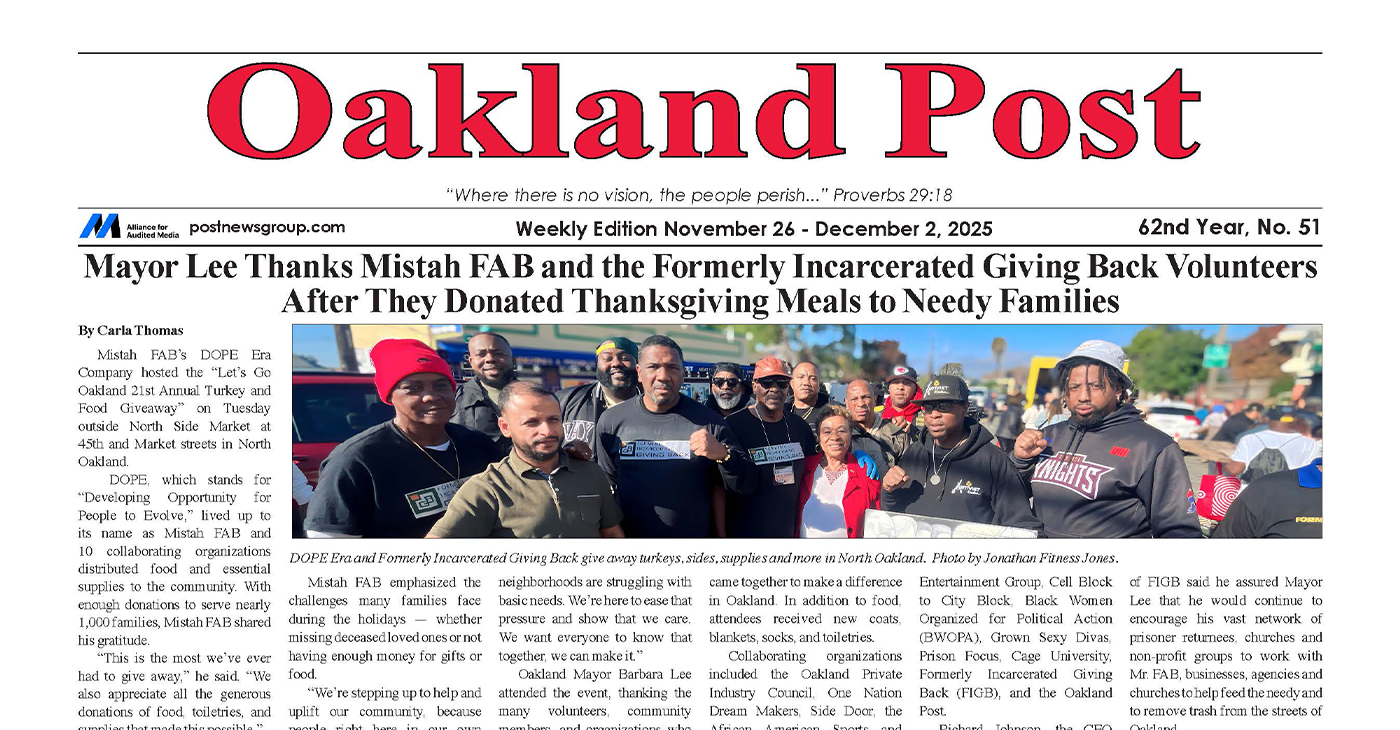
To enlarge your view of this issue, use the slider, magnifying glass icon or full page icon in the lower right corner of the browser window.
Activism
Oakland Post: Week of November 19 – 25, 2025
The printed Weekly Edition of the Oakland Post: Week of November 19 – 25, 2025
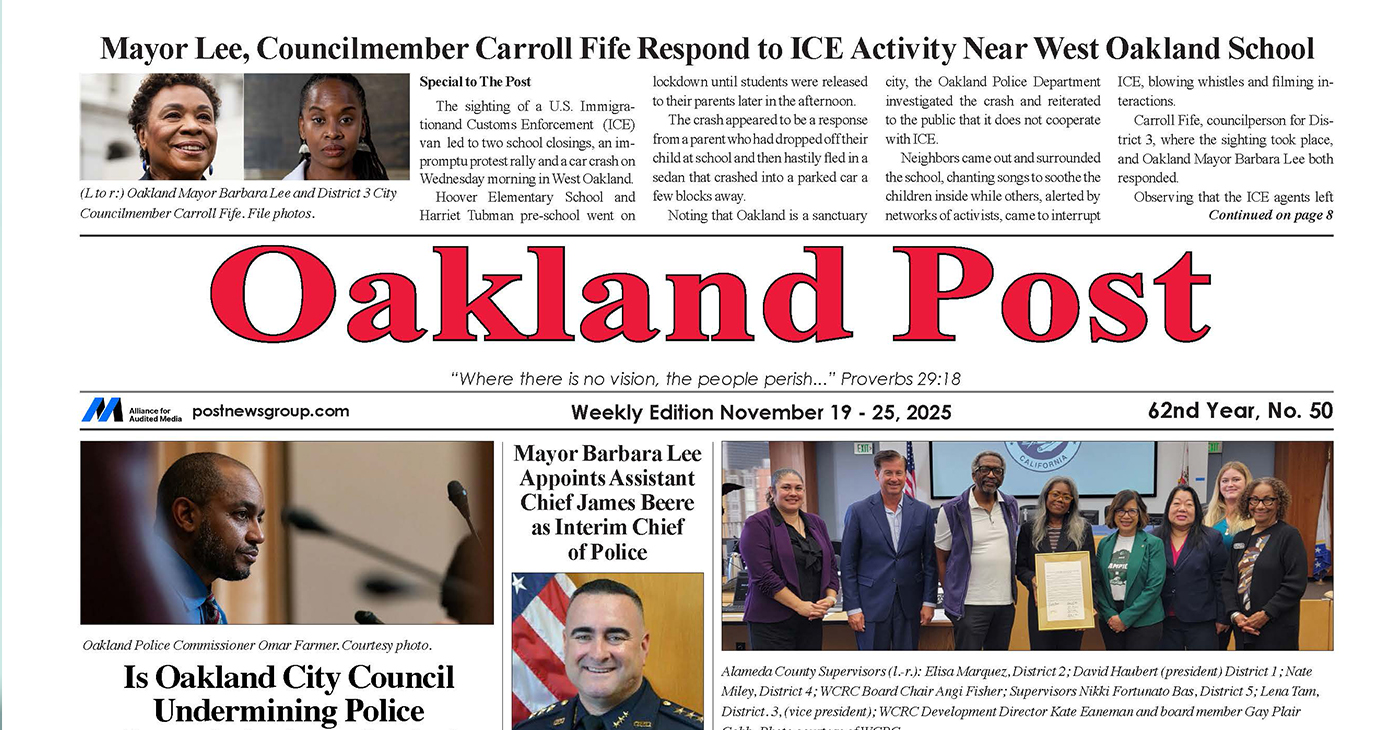
To enlarge your view of this issue, use the slider, magnifying glass icon or full page icon in the lower right corner of the browser window.
Activism
IN MEMORIAM: William ‘Bill’ Patterson, 94
Bill devoted his life to public service and education. In 1971, he became the founding director for the Peralta Community College Foundation, he also became an administrator for Oakland Parks and Recreation overseeing 23 recreation centers, the Oakland Zoo, Children’s Fairyland, Lake Merritt, and the Henry J. Kaiser Convention Center.
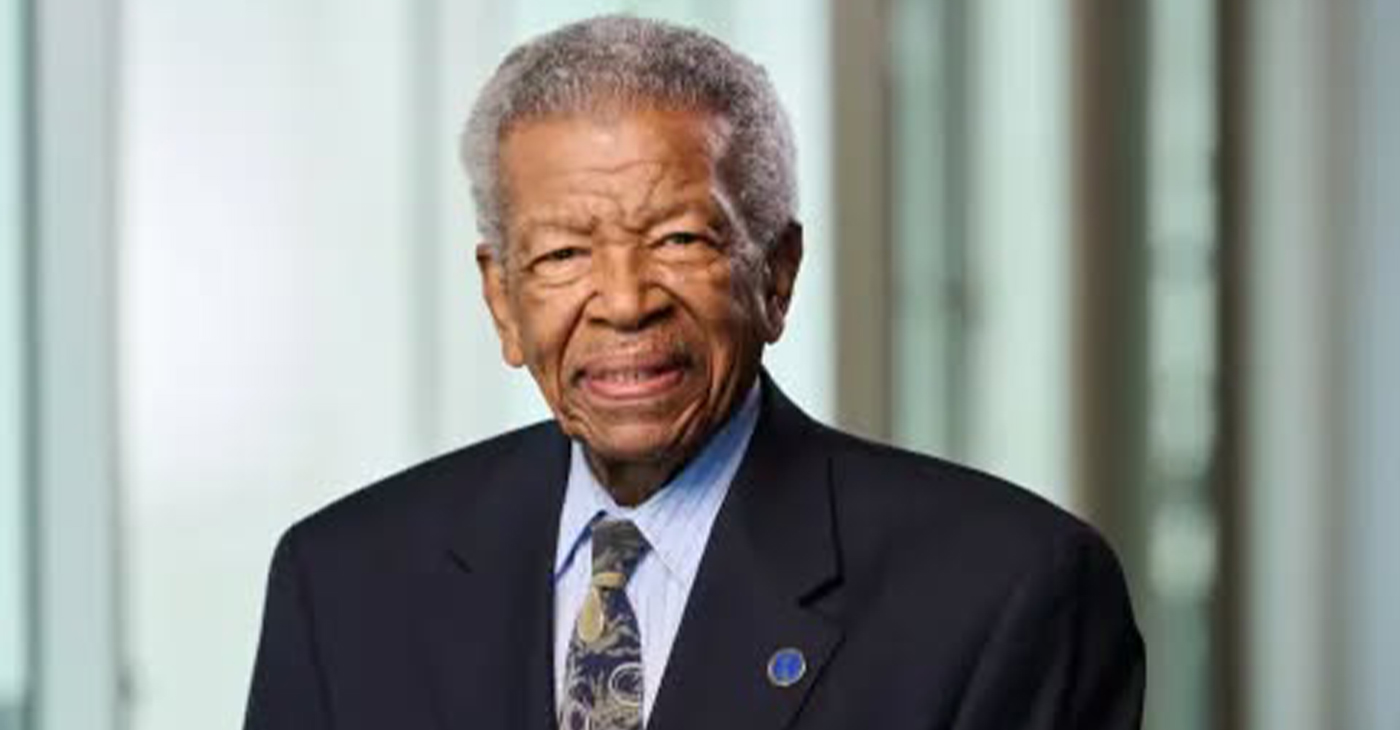
William “Bill” Patterson, 94, of Little Rock, Arkansas, passed away peacefully on October 21, 2025, at his home in Oakland, CA. He was born on May 19, 1931, to Marie Childress Patterson and William Benjamin Patterson in Little Rock, Arkansas. He graduated from Dunbar High School and traveled to Oakland, California, in 1948. William Patterson graduated from San Francisco State University, earning both graduate and undergraduate degrees. He married Euradell “Dell” Patterson in 1961. Bill lovingly took care of his wife, Dell, until she died in 2020.
Bill devoted his life to public service and education. In 1971, he became the founding director for the Peralta Community College Foundation, he also became an administrator for Oakland Parks and Recreation overseeing 23 recreation centers, the Oakland Zoo, Children’s Fairyland, Lake Merritt, and the Henry J. Kaiser Convention Center.
He served on the boards of Oakland’s Urban Strategies Council, the Oakland Public Ethics Commission, and the Oakland Workforce Development Board.
He was a three-term president of the Oakland branch of the NAACP.
Bill was initiated in the Gamma Alpha chapter of Kappa Alpha Psi Fraternity.
In 1997 Bill was appointed to the East Bay Utility District Board of Directors. William Patterson was the first African American Board President and served the board for 27 years.
Bill’s impact reached far beyond his various important and impactful positions.
Bill mentored politicians, athletes and young people. Among those he mentored and advised are legends Joe Morgan, Bill Russell, Frank Robinson, Curt Flood, and Lionel Wilson to name a few.
He is survived by his son, William David Patterson, and one sister, Sarah Ann Strickland, and a host of other family members and friends.
A celebration of life service will take place at Henry J. Kaiser Convention Center (Calvin Simmons Theater) on November 21, 2025, at 10 AM.
His services are being livestreamed at: https://www.facebook.com/events/1250167107131991/
In lieu of flowers, donations can be made to the Euradell and William Patterson scholarship fund TBA.
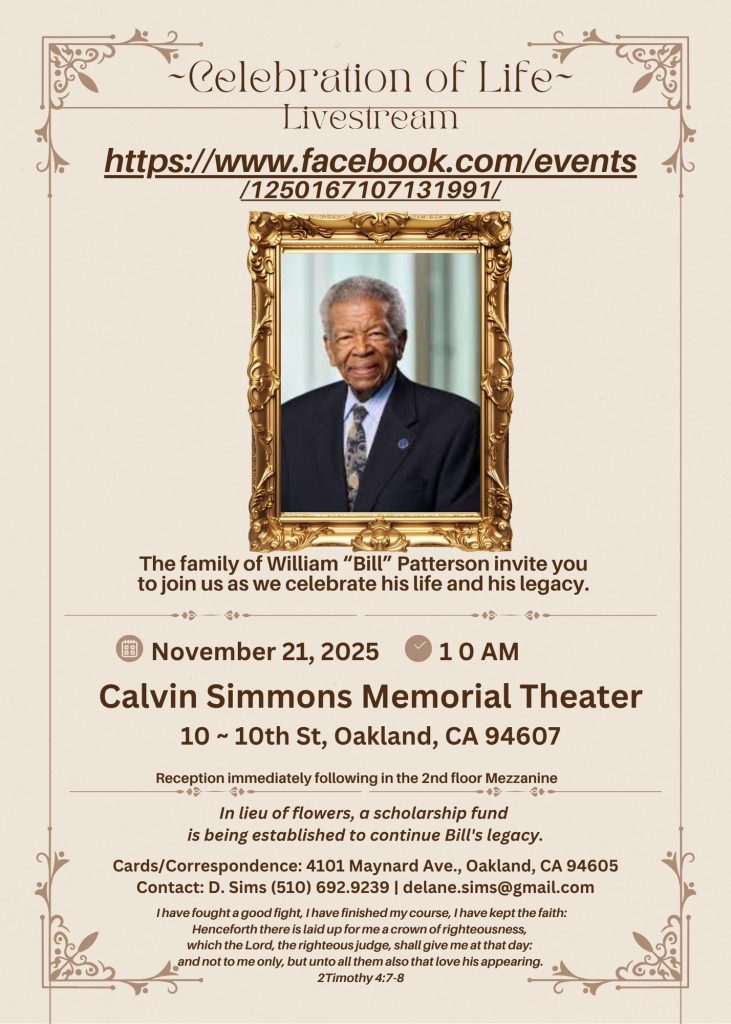
-

 Activism3 weeks ago
Activism3 weeks agoOakland Post: Week of November 12 – 18, 2025
-

 Activism4 weeks ago
Activism4 weeks agoOakland Post: Week of November 5 – 11, 2025
-

 Activism2 weeks ago
Activism2 weeks agoIN MEMORIAM: William ‘Bill’ Patterson, 94
-

 Activism3 weeks ago
Activism3 weeks agoHow Charles R. Drew University Navigated More Than $20 Million in Fed Cuts – Still Prioritizing Students and Community Health
-

 #NNPA BlackPress3 weeks ago
#NNPA BlackPress3 weeks agoThe Perfumed Hand of Hypocrisy: Trump Hosted Former Terror Suspect While America Condemns a Muslim Mayor
-

 Bay Area3 weeks ago
Bay Area3 weeks agoNo Justice in the Justice System
-

 #NNPA BlackPress3 weeks ago
#NNPA BlackPress3 weeks agoProtecting Pedophiles: The GOP’s Warped Crusade Against Its Own Lies
-

 #NNPA BlackPress2 weeks ago
#NNPA BlackPress2 weeks agoTrump’s Death Threat Rhetoric Sends Nation into Crisis







